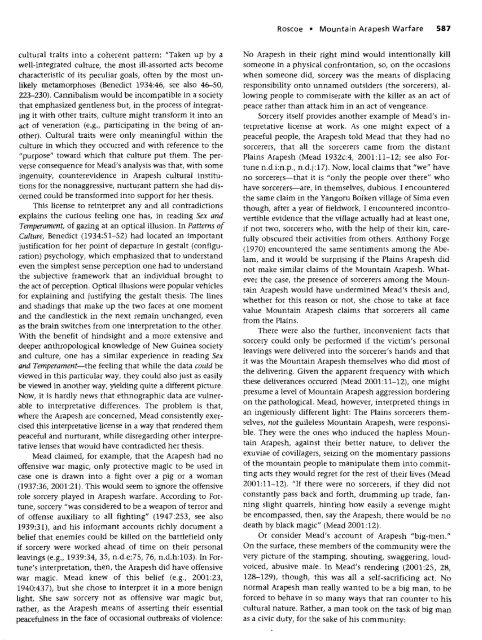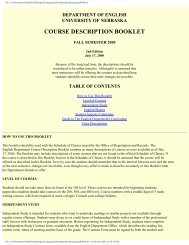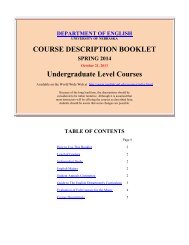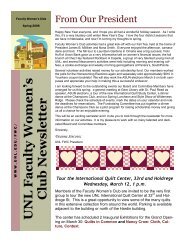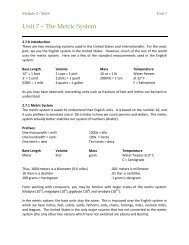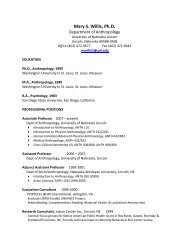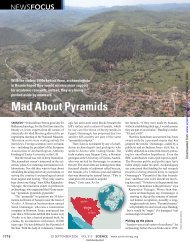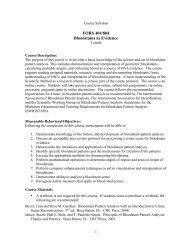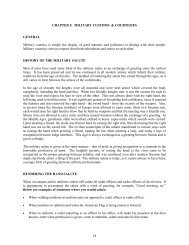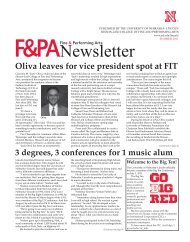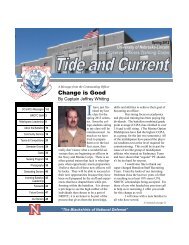Margaret Mead, Reo Fortune, and Mountain Arapesh Warfare
Margaret Mead, Reo Fortune, and Mountain Arapesh Warfare
Margaret Mead, Reo Fortune, and Mountain Arapesh Warfare
You also want an ePaper? Increase the reach of your titles
YUMPU automatically turns print PDFs into web optimized ePapers that Google loves.
cultural traits into a coherent pattern: "Taken up by a<br />
well-integrated culture, the most ill-assorted acts become<br />
characteristic of its peculiar goals, often by the most unlikely<br />
metamorphoses (Benedict 1934:46, see also 46-50,<br />
223-230). Cannibalism would be incompatible in a society<br />
that emphasized gentleness but, in the process of integrating<br />
it with other traits, culture might transform it into an<br />
act of veneration (e.g., participating in the being of another).<br />
Cultural traits were only meaningful within the<br />
culture in which they occurred <strong>and</strong> with reference to the<br />
"purpose" toward which that culture put them. The perverse<br />
consequence for <strong>Mead</strong>'s analysis was that, with some<br />
ingenuity, counterevidence in <strong>Arapesh</strong> cultural institutions<br />
for the nonaggressive, nurturant pattern she had discerned<br />
could be transformed into support for her thesis.<br />
This license to reinterpret any <strong>and</strong> all contradictions<br />
explains the curious feeling one has, in reading Sex <strong>and</strong><br />
Temperament, of gazing at an optical illusion. In Patterns of<br />
Culture, Benedict (1934:51-52) had located an important<br />
justification for her point of departure in gestalt (configuration)<br />
psychology, which emphasized that to underst<strong>and</strong><br />
even the simplest sense perception one had to underst<strong>and</strong><br />
the subjective framework that an individual brought to<br />
the act of perception. Optical illusions were popular vehicles<br />
for explaining <strong>and</strong> justifying the gestalt thesis. The lines<br />
<strong>and</strong> shadings that make up the two faces at one moment<br />
<strong>and</strong> the c<strong>and</strong>lestick in the next remain unchanged, even<br />
as the brain switches from one interpretation to the other.<br />
With the benefit of hindsight <strong>and</strong> a more extensive <strong>and</strong><br />
deeper anthropological knowledge of New Guinea society<br />
<strong>and</strong> culture, one has a similar experience in reading Sex<br />
<strong>and</strong> Temperament—the feeling that while the data could be<br />
viewed in this particular way, they could also just as easily<br />
be viewed in another way, yielding quite a different picture.<br />
Now, it is hardly news that ethnographic data are vulnerable<br />
to interpretative differences. The problem is that,<br />
where the <strong>Arapesh</strong> are concerned, <strong>Mead</strong> consistently exercised<br />
this interpretative license in a way that rendered them<br />
peaceful <strong>and</strong> nurturant, while disregarding other interpretative<br />
lenses that would have contradicted her thesis.<br />
<strong>Mead</strong> claimed, for example, that the <strong>Arapesh</strong> had no<br />
offensive war magic, only protective magic to be used in<br />
case one is drawn into a fight over a pig or a woman<br />
(1937:36, 2001:21). This would seem to ignore the offensive<br />
role sorcery played in <strong>Arapesh</strong> warfare. According to <strong>Fortune</strong>,<br />
sorcery "was considered to be a weapon of terror <strong>and</strong><br />
of offense auxiliary to all fighting" (1947:253, see also<br />
1939:31), <strong>and</strong> his informant accounts richly document a<br />
belief that enemies could be killed on the battlefield only<br />
if sorcery were worked ahead of time on their personal<br />
leavings (e.g., 1939:34, 35, n.d.e:75, 76, n.d.h:103). In <strong>Fortune</strong>'s<br />
interpretation, then, the <strong>Arapesh</strong> did have offensive<br />
war magic. <strong>Mead</strong> knew of this belief (e.g., 2001:23,<br />
1940:437), but she chose to interpret it in a more benign<br />
light. She saw sorcery not as offensive war magic but,<br />
rather, as the <strong>Arapesh</strong> means of asserting their essential<br />
peacefulness in the face of occasional outbreaks of violence:<br />
Roscoe • <strong>Mountain</strong> <strong>Arapesh</strong> <strong>Warfare</strong> 587<br />
No <strong>Arapesh</strong> in their right mind would intentionally kill<br />
someone in a physical confrontation, so, on the occasions<br />
when someone did, sorcery was the means of displacing<br />
responsibility onto unnamed outsiders (the sorcerers), allowing<br />
people to commiserate with the killer as an act of<br />
peace rather than attack him in an act of vengeance.<br />
Sorcery itself provides another example of <strong>Mead</strong>'s interpretative<br />
license at work. As one might expect of a<br />
peaceful people, the <strong>Arapesh</strong> told <strong>Mead</strong> that they had no<br />
sorcerers, that all the sorcerers came from the distant<br />
Plains <strong>Arapesh</strong> (<strong>Mead</strong> 1932c:4, 2001:11-12; see also <strong>Fortune</strong><br />
n.d.i.n.p., n.d.j:17). Now, local claims that "we" have<br />
no sorcerers—that it is "only the people over there" who<br />
have sorcerers—are, in themselves, dubious. I encountered<br />
the same claim in the Yangoru Boiken village of Sima even<br />
though, after a year of fieldwork, I encountered incontrovertible<br />
evidence that the village actually had at least one,<br />
if not two, sorcerers who, with the help of their kin, carefully<br />
obscured their activities from others. Anthony Forge<br />
(1970) encountered the same sentiments among the Abelam,<br />
<strong>and</strong> it would be surprising if the Plains <strong>Arapesh</strong> did<br />
not make similar claims of the <strong>Mountain</strong> <strong>Arapesh</strong>. Whatever<br />
the case, the presence of sorcerers among the <strong>Mountain</strong><br />
<strong>Arapesh</strong> would have undermined <strong>Mead</strong>'s thesis <strong>and</strong>,<br />
whether for this reason or not, she chose to take at face<br />
value <strong>Mountain</strong> <strong>Arapesh</strong> claims that sorcerers all came<br />
from the Plains.<br />
There were also the further, inconvenient facts that<br />
sorcery could only be performed if the victim's personal<br />
leavings were delivered into the sorcerer's h<strong>and</strong>s <strong>and</strong> that<br />
it was the <strong>Mountain</strong> <strong>Arapesh</strong> themselves who did most of<br />
the delivering. Given the apparent frequency with which<br />
these deliverances occurred (<strong>Mead</strong> 2001:11-12), one might<br />
presume a level of <strong>Mountain</strong> <strong>Arapesh</strong> aggression bordering<br />
on the pathological. <strong>Mead</strong>, however, interpreted things in<br />
an ingeniously different light: The Plains sorcerers themselves,<br />
not the guileless <strong>Mountain</strong> <strong>Arapesh</strong>, were responsible.<br />
They were the ones who induced the hapless <strong>Mountain</strong><br />
<strong>Arapesh</strong>, against their better nature, to deliver the<br />
exuviae of covillagers, seizing on the momentary passions<br />
of the mountain people to manipulate them into committing<br />
acts they would regret for the rest of their lives (<strong>Mead</strong><br />
2001:11-12). "If there were no sorcerers, if they did not<br />
constantly pass back <strong>and</strong> forth, drumming up trade, fanning<br />
slight quarrels, hinting how easily a revenge might<br />
be encompassed, then, say the <strong>Arapesh</strong>, there would be no<br />
death by black magic" (<strong>Mead</strong> 2001:12).<br />
Or consider <strong>Mead</strong>'s account of <strong>Arapesh</strong> "big-men."<br />
On the surface, these members of the community were the<br />
very picture of the stamping, shouting, swaggering, loudvoiced,<br />
abusive male. In <strong>Mead</strong>'s rendering (2001:25, 28,<br />
128-129), though, this was all a self-sacrificing act. No<br />
normal <strong>Arapesh</strong> man really wanted to be a big man, to be<br />
forced to behave in so many ways that ran counter to his<br />
cultural nature. Rather, a man took on the task of big man<br />
as a civic duty, for the sake of his community:


